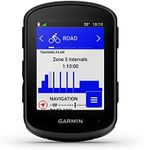Buying Guide for the Best Cycling Computers
Choosing the right cycling computer can greatly enhance your biking experience, whether you're a casual rider or a competitive cyclist. A cycling computer is a device that attaches to your bike and provides valuable data about your ride, such as speed, distance, and sometimes even navigation. When selecting a cycling computer, consider what features are most important to you based on your cycling goals and habits. Understanding the key specifications will help you make an informed decision that aligns with your needs.Display Size and TypeThe display size and type of a cycling computer are crucial because they determine how easily you can read the information while riding. Larger displays are easier to read, especially in bright sunlight, but they may add bulk to your handlebars. Smaller displays are more compact and lightweight, which might be preferable for minimalist setups. Consider how much information you want visible at once and whether you need a backlit or color display for better visibility in various lighting conditions.
GPS FunctionalityGPS functionality in cycling computers allows you to track your route and navigate unfamiliar areas. This is particularly important for cyclists who enjoy exploring new trails or need precise data for training purposes. Some devices offer basic GPS tracking, while others provide advanced navigation features with turn-by-turn directions. If you often ride in new locations or participate in long-distance events, a cycling computer with robust GPS capabilities will be beneficial.
ConnectivityConnectivity refers to the cycling computer's ability to sync with other devices and apps, such as smartphones, heart rate monitors, and cycling apps. This feature is important for cyclists who want to analyze their performance data or share their rides on social media. Look for computers that offer Bluetooth or ANT+ connectivity if you plan to use additional sensors or integrate your data with fitness platforms. If you're a tech-savvy cyclist who enjoys detailed analytics, prioritize models with strong connectivity options.
Battery LifeBattery life is a critical spec for cycling computers, especially for long rides or multi-day tours. Longer battery life means less frequent charging and more reliable performance during extended rides. Some models offer rechargeable batteries, while others use replaceable ones. Consider how often you ride and for how long; if you're a long-distance cyclist, opt for a computer with extended battery life to ensure it lasts throughout your journey.
Data Tracking FeaturesData tracking features include metrics like speed, distance, cadence, and heart rate. These are important for cyclists who want to monitor their performance and progress over time. Basic models may only track speed and distance, while advanced ones offer comprehensive data analysis. Determine which metrics are most important for your training or recreational riding, and choose a computer that provides the necessary data to meet your goals.
Durability and Weather ResistanceDurability and weather resistance are essential for cycling computers, as they need to withstand various environmental conditions. Look for models that are water-resistant or waterproof, especially if you frequently ride in rainy or muddy conditions. Additionally, consider the build quality and materials used, as a durable computer will last longer and perform reliably in different terrains. If you're an adventurous cyclist who rides in diverse weather, prioritize durability and weather resistance.















